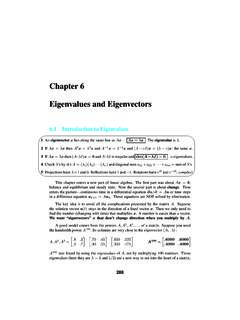Transcription of Introduction to Vectors and Tensors Volume 1
1 Updated 2010 Introduction TO Vectors AND Tensors linear and Multilinear Algebra Volume 1 Ray M. Bowen Mechanical Engineering Texas A&M University College Station, Texas and Wang Mathematical Sciences Rice University Houston, Texas Copyright Ray M. Bowen and Wang (ISBN 0-306-37508-7 (v. 1)) iii _____ PREFACE To Volume 1 This work represents our effort to present the basic concepts of vector and tensor analysis. Volume I begins with a brief discussion of algebraic structures followed by a rather detailed discussion of the algebra of Vectors and Tensors . Volume II begins with a discussion of Euclidean Manifolds which leads to a development of the analytical and geometrical aspects of vector and tensor fields. We have not included a discussion of general differentiable manifolds.
2 However, we have included a chapter on vector and tensor fields defined on Hypersurfaces in a Euclidean Manifold. In preparing this two Volume work our intention is to present to Engineering and Science students a modern Introduction to Vectors and Tensors . Traditional courses on applied mathematics have emphasized problem solving techniques rather than the systematic development of concepts. As a result, it is possible for such courses to become terminal mathematics courses rather than courses which equip the student to develop his or her understanding further. As Engineering students our courses on Vectors and Tensors were taught in the traditional way. We learned to identify Vectors and Tensors by formal transformation rules rather than by their common mathematical structure. The subject seemed to consist of nothing but a collection of mathematical manipulations of long equations decorated by a multitude of subscripts and superscripts.
3 Prior to our applying vector and tensor analysis to our research area of modern continuum mechanics, we almost had to relearn the subject. Therefore, one of our objectives in writing this book is to make available a modern introductory textbook suitable for the first in-depth exposure to Vectors and Tensors . Because of our interest in applications, it is our hope that this book will aid students in their efforts to use Vectors and Tensors in applied areas. The presentation of the basic mathematical concepts is, we hope, as clear and brief as possible without being overly abstract. Since we have written an introductory text, no attempt has been made to include every possible topic. The topics we have included tend to reflect our personal bias. We make no claim that there are not other introductory topics which could have been included. Basically the text was designed in order that each Volume could be used in a one-semester course.
4 We feel Volume I is suitable for an introductory linear algebra course of one semester. Given this course, or an equivalent, Volume II is suitable for a one semester course on vector and tensor analysis. Many exercises are included in each Volume . However, it is likely that teachers will wish to generate additional exercises. Several times during the preparation of this book we taught a one semester course to students with a very limited background in linear algebra and no background in tensor analysis. Typically these students were majoring in Engineering or one of the Physical Sciences. However, we occasionally had students from the Social Sciences. For this one semester course, we covered the material in Chapters 0, 3, 4, 5, 7 and 8 from Volume I and selected topics from Chapters 9, 10, and 11 from Volume 2. As to level, our classes have contained juniors, iv PREFACE seniors and graduate students.
5 These students seemed to experience no unusual difficulty with the material. It is a pleasure to acknowledge our indebtedness to our students for their help and forbearance. Also, we wish to thank the U. S. National Science Foundation for its support during the preparation of this work. We especially wish to express our appreciation for the patience and understanding of our wives and children during the extended period this work was in preparation. Houston, Texas v _____ CONTENTS Vol. 1 linear and Multilinear Algebra Contents of Volume vii PART I BASIC MATHEMATICS Selected Readings for Part 2 CHAPTER 0 Elementary Matrix 3 CHAPTER 1 Sets, Relations, and 13 Section 1. Sets and Set 13 Section 2. Ordered Pairs" Cartesian Products" and 16 Section 3. 18 CHAPTER 2 Groups, Rings and 23 Section 4.
6 The Axioms for a 23 Section 5. Properties of a 26 Section 6. Group 29 Section 7. Rings and 33 PART II VECTOR AND TENSOR ALGEBRA Selected Readings for Part 40 CHAPTER 3 Vector 41 Section 8. The Axioms for a Vector 41 Section 9. linear Independence, Dimension and 46 Section 10. Intersection, Sum and Direct Sum of 55 Section 11. Factor 59 Section 12. Inner Product 62 Section 13. Orthogonal Bases and Orthogonal 69 Section 14. Reciprocal Basis and Change of 75 CHAPTER 4. linear 85 Section 15. Definition of a linear 85 CONTENTS OF Volume 1 vi Section 16. Sums and Products of linear 93 Section 17. Special Types of linear 97 Section 18. The Adjoint of a linear 105 Section 19. Component 118 CHAPTER 5. Determinants and 125 Section 20.
7 The Generalized Kronecker Deltas and the Summation 125 Section 21. 130 Section 22. The Matrix of a linear 136 Section 23 Solution of Systems of linear 142 CHAPTER 6 Spectral 145 Section 24. Direct Sum of 145 Section 25. Eigenvectors and 148 Section 26. The Characteristic 151 Section 27. Spectral Decomposition for Hermitian 158 Section 28. Illustrative 171 Section 29. The Minimal 176 Section 30. Spectral Decomposition for Arbitrary 182 CHAPTER 7. Tensor 203 Section 31. linear Functions, the Dual 203 Section 32. The Second Dual Space, Canonical 213 Section 33. Multilinear Functions, 218 Section 34. 229 Section 35. Tensors on Inner Product 235 CHAPTER 8. Exterior 247 Section 36.
8 Skew-Symmetric Tensors and Symmetric 247 Section 37. The Skew-Symmetric 250 Section 38. The Wedge 256 Section 39. Product Bases and Strict 263 Section 40. Determinants and 271 Section 41. 280 Section 42. Transformation to Contravariant 287 . vii _____ CONTENTS Vol. 2 Vector and Tensor Analysis PART III. VECTOR AND TENSOR ANALYSIS Selected Readings for Part 296 CHAPTER 9. Euclidean 297 Section 43. Euclidean Point 297 Section 44. Coordinate 306 Section 45. Transformation Rules for Vector and Tensor 324 Section 46. Anholonomic and Physical Components of 332 Section 47. Christoffel Symbols and Covariant 339 Section 48. Covariant Derivatives along 353 CHAPTER 10. Vector Fields and Differential 359 Section 49. Lie 359 Section 5O. Frobenius 368 Section 51.
9 Differential Forms and Exterior 373 Section 52. The Dual Form of Frobenius Theorem: the Poincar 381 Section 53. Vector Fields in a Three-Dimensiona1 Euclidean Manifold, I. Invariants and Intrinsic 389 Section 54. Vector Fields in a Three-Dimensiona1 Euclidean Manifold, II. Representations for Special Class of Vector 399 CHAPTER 11. Hypersurfaces in a Euclidean Manifold Section 55. Normal Vector, Tangent Plane, and Surface Metric 407 Section 56. Surface Covariant Derivatives 416 Section 57. Surface Geodesics and the Exponential Map 425 Section 58. Surface Curvature, I. The Formulas of Weingarten and Gauss 433 Section 59.
10 Surface Curvature, II. The Riemann-Christoffel Tensor and the Ricci Identities 443 Section 60. Surface Curvature, III. The Equations of Gauss and Codazzi 449 Section 61. Surface Area, Minimal Surface 454 CONTENTS OF Volume 11 viii Section 62. Surfaces in a Three-Dimensional Euclidean Manifold 457 CHAPTER 12. Elements of Classical Continuous Groups Section 63. The General linear Group and Its Subgroups 463 Section 64. The Parallelism of Cartan 469 Section 65. One-Parameter Groups and the Exponential Map 476 Section 66. Subgroups and Subalgebras 482 Section 67. Maximal Abelian Subgroups and Subalgebras 486 CHAPTER 13. Integration of Fields on Euclidean Manifolds, Hypersurfaces, and Continuous Groups Section 68. Arc Length, Surface Area, and Volume 491 Section 69.








